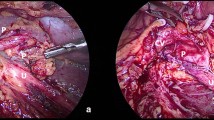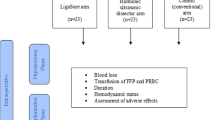Abstract
Purpose
This study was aimed to compare lymphatic complications of bipolar vessel sealing system with silk ligation of lymphatic vessels among renal transplant recipients.
Methods
This was a prospective randomized controlled trial done among 68 patients undergoing renal transplantation in Tribhuvan University Teaching Hospital. They were randomly assigned to either silk ligation or Enseal bipolar vessel sealing lymphatic dissection. Postoperative drain volume and duration of drain placement were measured in all patients. Ultrasound was used to find lymphocele formation in six and 12 weeks.
Results
Total of 30 patients in silk ligation group and 28 patients in bipolar vessel sealing group were analyzed. The baseline characteristics of the patients in each group were similar. Overall, lymphatic complications (either lymphorrhea or lymphocele formation) were in 16 cases (27.58%), 7 (25%) in the bipolar group, and 9 (30%) in the silk ligation group (p = 0.67). A total of 13 patients (22.41%) had lymphorrhea, 6 (21.4%) patients in the bipolar group, and 7 (23.3%) patients in the silk ligation group. Median drain volume was 415 ml (Q1 275 ml, Q3 675 ml) in the bipolar group and 542 ml (Q1 290, Q3 775) in silk group (p = 0.72). Median drain removal day was 5 in each bipolar and silk group with Q1 and Q3 being 5 days in each arm (p = 0.95). A total of five patients (8.62%) developed symptomatic lymphocele, two (7.1%) in the bipolar group, and three (10%) in the silk ligation group, but the difference was not statistically significant. In univariate analysis, double renal arteries in the donor's kidney (p = 0.03) and graft rejection (p = 0.04) were risk factors for the development of lymphatic complications. However, in multivariable analysis, these factors were not statistically significant.
Conclusions
This study did not find any significant differences in lymphatic complications between bipolar vessel sealing system and silk ligation. However, large sample multi-centric studies should be done to add evidences on lymphatic complications differences between these two techniques.
Trial registration number
UMIN000039354, Date of registration—2020, Feb 01.


Similar content being viewed by others
References
Ebadzadeh MR, Tavakkoli M (2008) Lymphocele after kidney transplantation: where are we standing now? Urol J 5(3):144–148
Veeramani M et al (2010) Does rejection have a role in lymphocele formation post renal transplantation? A single centre experience. Indian J Urol 26(2):193–195
Leonardo C et al (2005) Laparoscopic nephrectomy using Ligasure system: preliminary experience. J Endourol 19(8):976–978
Lucan CV et al (2017) Modern lymphatic dissection techniques for preventing post renal transplant lymphocele. Clujul Med 90(4):416–419
Zietek Z et al (2007) Lymphocele after kidney transplantation. Transplant Proc 39(9):2744–2747
Flores-Gama F, Bochicchio-Riccardelli T, Mondragón-Ramírez G (2010) Determination of creatinine in drained liquid Urinary leak or lymphocele? Cir Cir 78(4):327–332
Sansalone CV et al (2000) Is lymphocele in renal transplantation an avoidable complication? Am J Surg 179(3):182–185
Seki T et al (2016) A randomized controlled study comparing a vessel sealing system with the conventional technique in axillary lymph node dissection for primary breast cancer. Springerplus 5(1):1004
Simforoosh N et al (2019) Comparison between bipolar lymphatic vessels cautery and suture ligature in prevention of postrenal transplant lymphocele formation: a randomized controlled trial. Exp Clin Transplant 17(1):26–30
Mehrabi A et al (2020) Consensus on definition and severity grading of lymphatic complications after kidney transplantation. J Br Surg 107(7):801–811
Khosa Z, Mehboob M, Zubair C (2019) Post-renal transplant lymphorrhea and lymphocele: an unusual association with autosomal dominant polycystic kidney disease OPEN ACCESS Case Report. p 1085
Gupta RS et al (2001) Lymphoceles following renal transplantation: Comparison of open surgical and laparoscopic deroofing. Indian J Urol 18:36
Tsuda N et al (2014) Prevention of lymphocele development in gynecologic cancers by the electrothermal bipolar vessel sealing device. J Gynecol Oncol 25(3):229–235
Zagdoun E et al (2010) Complicated lymphoceles after kidney transplantation. Transplant Proc 42(10):4322–4325
Thomas C et al (2019) Development of symptomatic lymphoceles after radical prostatectomy and pelvic lymph node dissection is independent of surgical approach: a single-center analysis. Int Urol Nephrol 51(4):633–640
Tran M-H et al (2016) Kidney transplantation in obese patients. World J Transplant 6(1):135–143
Atray NK et al (2004) Post transplant lymphocele: a single centre experience. Clin Transplant 18(Suppl 12):46–49
Joosten M et al (2019) Predictors of symptomatic lymphocele after kidney transplantation. Int Urol Nephrol 51(12):2161–2167
Saidi RF et al (2008) Impact of donor kidney recovery method on lymphatic complications in kidney transplantation. Transpl Proc 40(4):1054–1055
Sakai Y, Kobayashi M (2015) Lymphocyte ‘homing’ and chronic inflammation. Pathol Int 65(7):344–354
Mazzucchi E et al (2005) Surgical complications after renal transplantation in grafts with multiple arteries. Int Braz J Urol 31(2):125–130
Goel M et al (2004) The influence of various maintenance immunosuppressive drugs on lymphocele formation and treatment after kidney transplantation. J Urol 171(5):1788–1792
Funding
Not applicable.
Author information
Authors and Affiliations
Corresponding author
Ethics declarations
Conflict of interest
The authors declare that they have competing interest.
Availability of data and material
Data available.
Code availability
Not applicable.
Ethics approval
Received.
Consent to participate
Consent taken.
Consent for publication
Available.
Additional information
Publisher's Note
Springer Nature remains neutral with regard to jurisdictional claims in published maps and institutional affiliations.
Rights and permissions
About this article
Cite this article
Sigdel, P.R., Gnyawali, D., Thapa, J. et al. Bipolar vessel sealing system versus silk ligation of lymphatic vessels in renal transplant recipient lymphatic complications: a randomized controlled trial. Int Urol Nephrol 53, 2477–2483 (2021). https://doi.org/10.1007/s11255-021-03003-5
Received:
Accepted:
Published:
Issue Date:
DOI: https://doi.org/10.1007/s11255-021-03003-5




